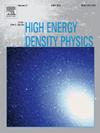Cosmological implications and ghost dark energy model in f(Q,C) gravity
IF 0.9
3区 物理与天体物理
Q3 PHYSICS, FLUIDS & PLASMAS
引用次数: 0
Abstract
The primary purpose of this work is to examine the ghost dark energy model in the framework of gravity, where denotes the non-metricity and defines the boundary term. For this objective, we examine a flat Friedmann–Robertson–Walker spacetime containing an ideal matter distribution. We investigate a scenario involving interacting fluids that include both dark energy and dark matter in this framework. Further, we reconstruct functional form to analyze the effects of this modified approach on the development of the cosmos. The reconstructed model reveals an increasing behavior for both non-metricity and redshift functions, indicating a viable cosmological model. We explore the behavior of various cosmic parameters with respect to different parametric values. The positive energy density and negative pressure suggest that the universe is in the accelerated expansion phase. The equation of state parameter falls in the phantom region, aligning with observational data. Additionally, the increasing behavior in the ()-plane indicates a freezing region, the -plane behavior corresponds to the Chaplygin gas model, reinforcing the model’s compatibility with current cosmological observations. This work provides new insights into the relationship between dark energy models and modified gravity theory, enhancing our understanding of cosmic evolution. Our findings align with the existing observational data (Ade et al., 2016), demonstrating that model accurately describes the dark energy and cosmic evolution.
f(Q,C)引力的宇宙学意义和幽灵暗能量模型
本工作的主要目的是在f(Q,C)引力框架下检验幽灵暗能量模型,其中Q表示非度规性,C定义边界项。为此,我们考察了一个包含理想物质分布的平坦的弗里德曼-罗伯逊-沃克时空。我们在这个框架中研究了一个涉及相互作用流体的场景,其中包括暗能量和暗物质。进一步,我们重建了f(Q,C)函数形式来分析这种修正方法对宇宙发展的影响。重建的f(Q,C)模型揭示了非度量性和红移函数的增加行为,表明了一个可行的宇宙学模型。我们探索各种宇宙参数相对于不同参数值的行为。正能量密度和负压力表明宇宙处于加速膨胀阶段。状态参数方程落在虚区,与观测数据一致。此外,(ωD−ωD’)平面的增加行为表明存在一个冻结区,(r−s)平面的行为符合Chaplygin气体模型,增强了该模型与当前宇宙学观测的兼容性。这项工作为暗能量模型和修正引力理论之间的关系提供了新的见解,增强了我们对宇宙演化的理解。我们的发现与现有的观测数据一致(Ade et al., 2016),表明f(Q,C)模型准确地描述了暗能量和宇宙演化。
本文章由计算机程序翻译,如有差异,请以英文原文为准。
求助全文
约1分钟内获得全文
求助全文
来源期刊

High Energy Density Physics
PHYSICS, FLUIDS & PLASMAS-
CiteScore
4.20
自引率
6.20%
发文量
13
审稿时长
6-12 weeks
期刊介绍:
High Energy Density Physics is an international journal covering original experimental and related theoretical work studying the physics of matter and radiation under extreme conditions. ''High energy density'' is understood to be an energy density exceeding about 1011 J/m3. The editors and the publisher are committed to provide this fast-growing community with a dedicated high quality channel to distribute their original findings.
Papers suitable for publication in this journal cover topics in both the warm and hot dense matter regimes, such as laboratory studies relevant to non-LTE kinetics at extreme conditions, planetary interiors, astrophysical phenomena, inertial fusion and includes studies of, for example, material properties and both stable and unstable hydrodynamics. Developments in associated theoretical areas, for example the modelling of strongly coupled, partially degenerate and relativistic plasmas, are also covered.
 求助内容:
求助内容: 应助结果提醒方式:
应助结果提醒方式:


